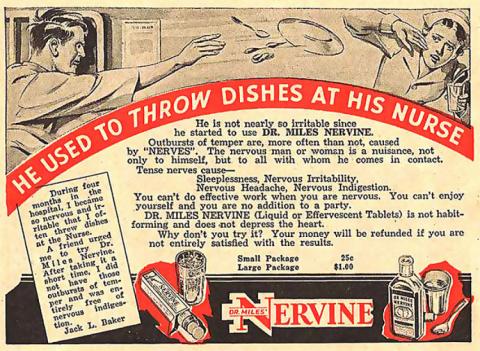Nervine made by Miles is a popular one on the internet. The Miles Medical company, founded in 1885 by Franklin Miles MD, was a big player in the patent medicine market. If you are a corporate lawyer, you know they were the plaintiffs in a very important 1912 lawsuit over whether or not they could dictate prices to their distributors and retailers. They lost, BTW. They created and marketed Alka-Seltzer. The company was sold to Bayer in 1979.
People love collecting their old bottles and enjoying their old ads.
What’s funny is that the internet tends to assume that Nervine was either a placebo or else full of something along the lines of alcohol or heroin. Not that the latter is such an unwarranted assumption. Until the early 20th century, when the US government began to insist that “medicines” actually list their ingredients, most patent medicines were flavored ethanol, leavened with something like opium, morphine or cocaine. If they couldn’t cure disease, they could sure make it a heck of a lot more enjoyable! Nervine, however, actually contained a working dose of an effective sedative.
Unfortunately, it was an effective sedative, not a safe one. The original Nervine contained bromine, which was the first non-narcotic sedative chemical. Invented in the mid-19th century, it was the go-to medication for epilepsy and agitation, until the invention of barbiturates in the early 20th century. Bromine worked well, but it was extremely easy to overdose on it because it stayed in the body so long.
When you overdosed on bromine, you got bromism. It is said that at one time bromism may have accounted for 5-10% of all psychiatric admissions. Symptoms included rash, nausea and vomiting, psychosis, weakness, ataxia, stupor and coma. Unfortunately it was perfectly possible to develop the condition with the standard therapeutic daily dose of 3-5 grams.
Human use of bromine in medications was banned in the US in 1975. It is apparently still available in Germany to treat childhood epilepsy, and is also used in the US to treat epilepsy in dogs. If you want a bromine blood level done these days, you have to go to a veterinary laboratory.
“Nervine” is till around today in a few different incarnations. The first is as an over-the-counter sleep aide, that now contains diphenhydramine, better known by the brand name Benadryl. It doesn’t seem to be marketed much in the US, if at all, but is well known in other countries. Somebody called Grandma’s Herbs markets a compound called Nervine as well—they better hope Bayer doesn’t find out. Here’s a link to a 2008 article about a schoolgirl in Korea overdosing on Nervine:
http://www.koreatimes.co.kr/www/news/include/print.asp?newsIdx=24901
(She was fine, but do click the link later because the story is all kinds of “what the---.“)
In a more abstract sense the term “nervine” also exists on the internet among the fringes of the alternative medicine community, where it is used to describe plants, compounds, or perhaps fairy dust that can have a sedative effect. Probably the people that use the term have unaware that they are referencing a patent medicine, but like it because it has that pseudoscientific ring to it that impresses those with more enthusiasm than education.

